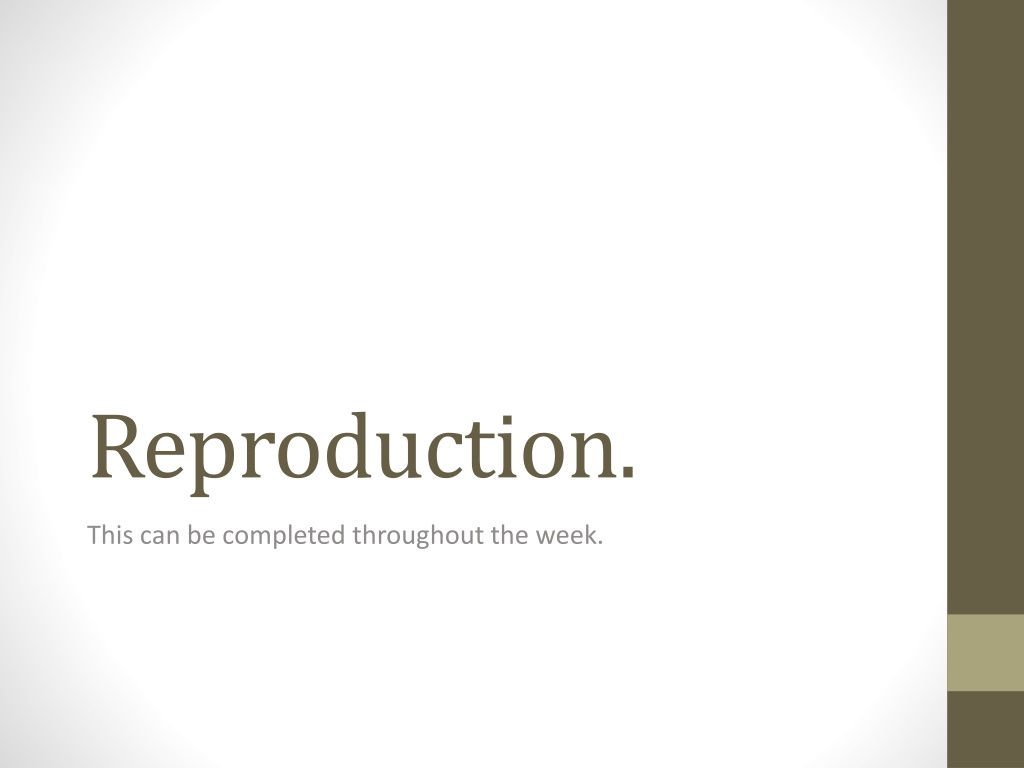Understanding Reproduction: Pollen, Eggs, and Life Cycles in Plants
Reproduction in plants involves the transfer of pollen to eggs, leading to fertilization and the formation of new life. Male animals produce sperm, while females produce eggs, which fertilize when they meet. Different animals exhibit external or internal fertilization, with varying numbers of offspring produced. Through hands-on tasks and research, learn about the importance of reproduction in nature and the factors influencing the number of babies born in different species.
Download Presentation

Please find below an Image/Link to download the presentation.
The content on the website is provided AS IS for your information and personal use only. It may not be sold, licensed, or shared on other websites without obtaining consent from the author. Download presentation by click this link. If you encounter any issues during the download, it is possible that the publisher has removed the file from their server.
E N D
Presentation Transcript
Reproduction. This can be completed throughout the week.
Can you remember Write down as much important information that you can remember about pollen and eggs in plants as well as life cycles.
Why do animals lay so many eggs? Male animals make sperm whilst females make eggs, When sperm meets an egg, the sperm fertilises the egg. This happens in many animals outside of the body.
Task 1-This is a model of the fertilisation process You will need: Cups Seeds (or something else that is similar size) Outdoor space. Place the plastic cups a few centimetres apart in a group. You are going to imagine that you are frogs. The birdseed is the sperm and the plastic cups are the eggs . You are going to throw the seeds in to the cups. If the seed manages to get into the cup it has been fertilised. Firstly, stand 2 meters away and try and throw the birdseed, one seed at a time, into the plastic cups. Count how many cups have been fertilised . Continue to next slide
Task 1-continued Now have another go at throwing the seeds into the cup. However, this time you will just have a handful of seeds and you will throw all of them at the same time into the cup (from 2 meters away). Are more fertilised than last time? Why? What does this show? In external fertilisation, large numbers of sperm and eggs are released. The reason so much sperm is released is that it increases the chances of eggs being fertilised.
Task 2 Research whether these animals fertilise inside or outside of the body and how many offspring are produced at a time. Horse Duck Frog Salmon Why do some have so many babies? Why do some only have a few? Create a poster listing the advantages and disadvantages of having one baby, then do the same for having hundreds.
Video Watch the video clip below. You should write down notes as you will need them for your last task for this week. https://www.bbc.co.uk/teach/class-clips-video/how-plants- and-animals-reproduce/zm8fbdm
Final Task After researching plants and animal reproduction over the past few weeks, now conduct further research on both these different types of reproduction. The websites below should get you started on your research. https://www.bbc.co.uk/bitesize/clips/zq7d7ty https://www.bbc.co.uk/bitesize/topics/zgssgk7/articles/z9xb3 9q https://www.youtube.com/watch?v=UwIsyZO0v28 Questions to think about: What are the advantages and disadvantages? Differences and similarities between the two?
How to present what you have discovered Here are a few ideas of different ways you could present your work. Flash cards/trivia cards- create questions and answers ( you can use these to test a sibling or your parents). Write a brochure/pamphlet Presentation Poster Create you own test for somebody else to complete. Use a Venn diagram to compare the similarities and differences between how plants and animals reproduce. Send your final pieces of work to your class teacher through the class emails: Miss Bates: 5rb@coundon.coventry.sch.uk Mr Scott: 5as@coundon.coventry.sch.uk Mr Tooby: 5jt@coundon.coventry.sch.uk































